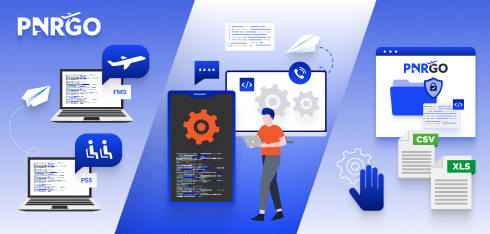Our first webinar was devoted to the topic of the new UK GAR requirements. We thank our attendees for their active participation, and all the questions asked in the chat. As promised, we are sharing the live recording of the presentation, and the Q&A session content with you!
New UK GAR – PART 1: Recording of the presentation
This recording covers the presentational part of our webinar, led by Małgorzata Woźniak, Certification & Enrollment Manager at PnrGo.
New UK GAR – PART 2: Questions & Answers
Below you can find the questions and answers from our live Q&A session. We have grouped them into a few categories for easier reference.
GAR submission process and legal aspects
Who will the UK contact in case of NO BOARD status? // What contact details does PnrGo send to the UK?
If you submit GAR manually via the web portal, you have to input the ‘responsible person’ in one of the submission steps. This can be a specific person or simply your OPS team. You will be asked to provide their contact details. The UK will use these details to inform you about the NO BOARD status.
If you are using the automated GAR service offered by PnrGo, the UK will reach you via the email and the contact number of your OPS team, provided during your onboarding process with us. If you are not sure what email address and phone number you have given to us, please get in touch with our support team and we will be happy to help!
What should I do if there is a system outage or the sGAR portal is down?
This can happen. There might be some scheduled maintenance works on the UK side. This will cause both the sGAR portal and the system-to-system connections (offered by data providers) to stop working (e.g. in June, the systems were down for the whole day).
In such a case, you need to go back to the ‘old’ way of submission, and send your GAR via email. If you are using PnrGo, we will do it on your behalf, switching to e-mail submissions for the time being. Bear in mind that when the systems are down, the GAR reference number is not issued.
I’ve heard that the fines might be up to 10,000 GBP. Do they give such high fines even for minor mistakes (e.g. misspelled name), or only for major violations (e.g. arrival without submitting GAR)? So far, we have received two warnings, without any fines yet.
It seems that for the first 3 months after the change in requirements, the UK mostly issued warnings. But it should not be treated as a ‘rule’ so let’s just call it a ‘grace’ period.
The UK regulations actually provide for a maximum penalty of £50,000 for carrying a passenger without permission. But the fines can be lower, of course. Theoretically, they start at 5,000 GBP for first time breaches with mitigating factors. From what we’ve heard from our customers, even minor mistakes, like a misspelled name (letters switched), can result in a fine, although we do not have the information what was the amount of penalty in that case. We highly advise you to double-check the data you enter into the system (regardless of whether you use sGAR or just input data in the FMS integrated with PnrGo). The UK is quite strict in this matter and even a small mistake can have big consequences.
Is GAR submission needed for domestic flights within the UK?
No, it’s not required. But if you’re flying from Ireland, the Channel Islands or the Isle of Man to the UK (or the other way round) – then GAR is needed both for the UK and the other location.
What happens if you have to divert to another airport due to bad weather conditions?
If there is a diversion due to bad weather, then this is an exceptional case which will not result in penalties. What you have to do is contact the UK Border Force and let them know that you are diverting your flight. But, of course, this is not a reason to turn around, submit a new GAR, and wait for 2 hours!
GAR re-submission / update and the 2-hour delays
The 2-hour flight delay is not required if you get the UK Border Force clearance by phone, correct? But you would not receive an 'OK board' message, would you?
Exactly. If you have a last-minute change, you have the option to call the local unit of the UK Border Force, inform them about the ‘major’ change, and ask if you can still depart on time. They may grant you permission to depart, but from our experience, this hardly ever happens. Also, there would be no confirmation message or email in such a case.
Is the 2-hour delay required after re-submitting GAR when changing the destination airport for a ferry flight, eg. EGGW-LIMJ > LIMC?
Yes, a destination change, even for a ferry flight, requires you to re-submit / update your GAR and delay the flight for 2 hours. You can try calling the UK Border Force to request their permission to depart on time but such permission is generally hard to obtain.
How exactly is the 2-hour delay calculated, following a last-minute change? Does it count from the moment of new GAR submission or update?
Yes, from the moment you send the final update via sGAR, or your data provider’s system (e.g. PnrGo) resubmits your GAR automatically, you need to wait for two hours to depart. If you are using PnrGo, you can count this time from the moment you received an email notification that your GAR had been submitted successfully.
Why do we have to wait for 2h to depart a flight that is only 3h long? Shouldn’t this be fine? I’ve tried to call the UK to depart earlier but they never allow it...
We have had the opportunity to speak with the person responsible for implementing these legal rules in the UK. Basically, they need at least 2 hours to ensure enough time for their screening procedures. This is to make sure that you will not bring any ‘blacklisted’ individuals to the UK. It’s the local law and we have to obey it if we want to fly to their country. Otherwise, they have the right to issue penalties.
What if GAR has been submitted for a LIML-EGGW flight ETD 12:00Z, and the passenger shows up at 11:00Z? Can we depart 1h earlier, without submitting a new GAR?
This depends on when the final version of GAR was submitted. For example: you sent the first GAR 12 hours before the flight, and there have been no changes – so this is your ‘final’ GAR. In this case, you can depart 1 hour earlier because the time between your GAR submission and departure is more than 2 hours. So this falls into the window for ‘small’ time changes (this window works both ways – that is, for delays and early departures). Just make sure you do not violate the 2-hour window between your final GAR submission and your departure.
Is my understanding correct – a delay within the same date of flight doesn't need a new GAR, but a change of date does? In this case, what is taken into account here – ‘the date of departure’ or ‘the date of arrival’ (in case they're not the same)? And should we look at the UTC time or the local time?
What we look at here is the time of departure.
We will give you an example which sits in the middle between the ‘change of date’ and a ‘small delay’. Let’s say you have a flight planned for 10 pm but you are delaying it for 3 hours so it’s now scheduled for the next day – it can still be considered as a ‘delay’ and not a ‘reschedule’. If the delay is larger, then submit a new GAR in this case.
In PnrGo, everything within a 3-hour window from STD is considered a ‘delay’ and not a ‘reschedule’. This was established with the UK during the development of our system-to-system connection, and so, in such cases, we do not submit a new GAR.
Passport data in GAR
In case the first name or the last name is missing from the passport, is it ok to input FNU (first name unknown) or LNU (last name unknown) in GAR?
The UK requires a slightly different approach – you should input the single name (regardless of whether it’s the given name or the last name) into the ‘surname’ field and put ‘unknown’ instead of the ‘first/given name’.
With PnrGo, this happens automatically. Our system will report the single name as a ‘surname’ and will input ‘unknown’ in place of the given name. So if you use our services, you can just leave the first name or the last name field empty, following the MRZ data from the passport, and we will handle this.
Do honorifics/titles – such as Miss, Dr, Lord – have to be inserted in GAR? I saw the example in your presentation, and ‘Miss’ was skipped.
It depends. If this title is not included in the Machine Readable Zone, you do not input it in GAR. If it’s included in the MRZ, then you should input it in GAR too, as part of the name.
Do you have any list with all the allowed special characters?
When it comes to special characters in names and surnames, it’s best to refer to the Machine Readable Zone in the passport and follow that spelling. Generally, hyphens (-) can be allowed, but sometimes in the MRZ they are also removed.
If you submit GAR with PnrGo and you input any disallowed characters, our system will sanitize your such data and apply the relevant transcription rules.
When it comes to names with special characters (e.g. German names with ß), how should that be entered in GAR?
Special characters – in most cases (we have mentioned the hyphen as an exception) – have to be transcribed. The transcription rules are not unified across the world so it’s best to follow the spelling from the MRZ. There will be no ß there – instead you will most likely find ‘SS’ instead.
Could you share some more real-life unusual situations that PnrGo has come across, please?
One such case concerns unusual passport data. We came across a passport where both in the visual part and in the MRZ part, there were two ‘versions’ of the name, like ‘George OR Georgie’. It was literally written like that! Of course, the name is not ‘George OR Georgie’, it’s more the case of the ‘allowed’ Latin transcriptions (this was a Greek passport so the original name was in the Greek alphabet). In that specific case, we know that the data sent to the UK contained only one version of the name (and not the full ‘George OR Georgie’), and the GAR submission was accepted.
If there is a passenger with two passports, can both passports be submitted so that the passenger can choose freely between them?
Unfortunately, no – this is not possible. There is only space for one document per passenger in GAR, regardless of whether you submit manually via sGAR or automatically through a data provider. So if you know that your passenger has two passports, you can either ask them to take both passports with them, or remind them to bring the one they gave you at the time of booking.
If a client has a passport full with stamps with him, is that ok for the UK Border Force?
The UK Border Force does not allow passengers with ‘full’ passports to enter the country. They consider such passports to be invalid. If you have already submitted your GAR using such a passport, you will have to resubmit, and include a passport that has free space for stamps.
[This response came from one of the webinar attendees so thank you for sharing your experience.]
PnrGo system
We got a warning from PnrGo saying that the ETD needs to be 2h later. After we changed the ETD, we didn't receive the green confirmation email from PnrGo. Why is that?
If you change the time of departure in a way that only ‘delays’ the flight (but is not considered a ‘reschedule’), the new GAR will not be sent – because it’s not required. The UK does not wish to be informed about such small changes. Our system will, therefore, ignore this time change. In such a case, you have the original GAR confirmation email sent by PnrGo (along with the 2-hour warning). There is no new confirmation email because there is no new GAR submission. You just have to delay the flight as advised, but you should not wait for a new confirmation email in such a case. If the ETD change becomes a ‘major’ change, a new GAR submission will be made, and a new confirmation email will be sent by our system.
Is it possible for PnrGo to add an alert in case the national ID data is provided and transmitted in GAR instead of the passport data?
This is not as straightforward as it seems. There are some exceptions where ID can be used for arrivals to the UK (e.g. people with a settled status). You can find these exceptions listed on the UK’s official website.
However, it is something we can discuss internally with our team when planning the product roadmap.
Can I change the passenger’s name manually in PnrGo?
This depends on how exactly you use PnrGo. Generally speaking, it is possible to change the name directly in our system. You can always log into our system, find the flight, and change the data manually. However, if you are using PnrGo via an FMS, it is not advisable! It’s better to have everything updated in your scheduling software as we are pulling the data from there.
Depending on the integration type, your manual change might:
- partly switch off the data synchronization between the systems (so we will no longer receive any updates regarding this part of the flight)
- be overwritten by your FMS during the next push of data.
PnrGo integrations
We are connected to many great flight management systems. Each integration works a bit differently. Below are the questions asked by our webinar attendees. If you are using a different system integrated with PnrGo, contact us directly to learn more about your integration.
FL3XX & PnrGo: What is the average time of data update between the systems?
When it comes to our integration with FL3XX, the data synchronization takes on average 5 min. Occasionally, if any of the systems is overloaded (be it on our side or on the UK’s side), it may take a bit longer. Still, the whole GAR data transfer – from FL3XX via PnrGo to the UK – should only take a couple of minutes, and you will always receive an email confirmation once your GAR has been submitted successfully. Bear in mind that this only applies to any data that is already ‘due’ for submission. The first GAR push time is always agreed with the PnrGo user during the onboarding. If the data is entered into the system before that, we will wait until the agreed time.
Leon Software & PnrGo: How long does it take for new data or updates to be pushed between the systems?
When it comes to our Leon Software integration, the average time of data update at the moment is 5 min. Occasionally, it may also happen that the systems are overloaded (be it on our side or on the UK’s side), and the whole GAR data update will take a bit longer. In general, however, the total time – from the moment you input/update your data in Leon to the moment you receive a confirmation of your new GAR submission – should not exceed 10 min. Bear in mind that this only applies to any data that is already ‘due’ for submission. The first GAR push time is always agreed with the PnrGo user during the onboarding. If the data is entered into the system before that, we will wait until the agreed time.
Next webinar
PnrGo will join EBAA as a guest speaker at the webinar on Entry Exit System (EES). The webinar is scheduled for September, 5th and the registration is now open.
Keep an eye on our LinkedIn profile or sign up to the newsletter to get notified about similar events in the future!



















